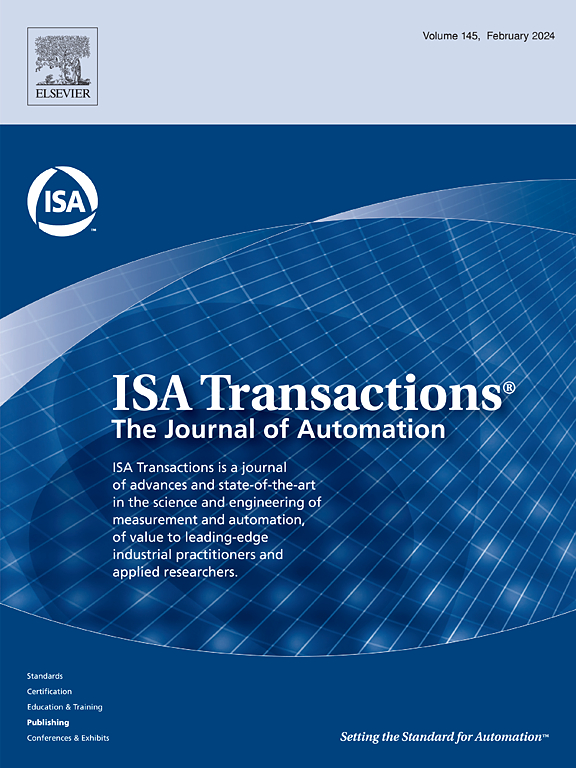Adaptive critic design for safety-optimal FTC of unknown nonlinear systems with asymmetric constrained-input
IF 6.3
2区 计算机科学
Q1 AUTOMATION & CONTROL SYSTEMS
引用次数: 0
Abstract
Safe fault tolerant control is one of the key technologies to improve the reliability of dynamic complex nonlinear systems with limited inputs, which is hard to solve and definitely a great challenge to tackle. Thus the paper presents a novel safety-optimal FTC (Fault Tolerant Control) approach for a category of completely unknown nonlinear systems incorporating actuator fault and asymmetric constrained-input, which can guarantee the system’s operation within a safe range while showcasing optimal performance. Firstly, a CBF (Control Barrier Function) is incorporated into the cost function to penalize unsafe behaviors, and then we translate the intractable safety-optimal FTC problem into a differential ZSG (Zero-Sum Game) problem by defining the control input and the actuator fault as two opposing sides. Secondly, a neural-network-based identifier is employed to reconstruct system dynamics using system data, and the resolution of handling asymmetric constrained-input with the introduced non-quadratic cost function is achieved through the design of an adaptive critic scheme, aiming to reduce computational expenses accordingly. Finally, through the theoretical stability analysis, it is demonstrated that all signals in the closed-loop system are consistently UUB (Uniformly Ultimately Bounded). Furthermore, the proposed method’s effectiveness is also verified in the simulation experiments conducted on a model of a single-link robotic arm system with actuator failure. The result shows that the algorithm can fulfill the safety-optimal demand of fault tolerant control in fault system with asymmetric constrained-input.
为具有非对称约束输入的未知非线性系统的安全最优 FTC 设计自适应批判器。
安全容错控制是提高具有有限输入的动态复杂非线性系统可靠性的关键技术之一,而这一问题很难解决,无疑是一项巨大的挑战。因此,本文针对一类包含执行器故障和非对称约束输入的完全未知非线性系统,提出了一种新颖的安全最优 FTC(容错控制)方法,该方法既能保证系统在安全范围内运行,又能展示其最优性能。首先,我们在成本函数中加入了 CBF(控制障碍函数)来惩罚不安全行为,然后通过将控制输入和执行器故障定义为对立双方,将难以解决的安全最优 FTC 问题转化为微分 ZSG(零和博弈)问题。其次,采用基于神经网络的识别器利用系统数据重建系统动力学,并通过设计自适应批判方案来解决处理非对称受限输入与引入的非二次成本函数的问题,旨在相应地减少计算费用。最后,通过理论稳定性分析,证明了闭环系统中的所有信号都是一致的 UUB(Uniformly Ultimately Bounded)。此外,还在一个执行器失效的单链杆机械臂系统模型上进行了仿真实验,验证了所提方法的有效性。结果表明,该算法能满足非对称约束输入故障系统容错控制的安全最优需求。
本文章由计算机程序翻译,如有差异,请以英文原文为准。
求助全文
约1分钟内获得全文
求助全文
来源期刊

ISA transactions
工程技术-工程:综合
CiteScore
11.70
自引率
12.30%
发文量
824
审稿时长
4.4 months
期刊介绍:
ISA Transactions serves as a platform for showcasing advancements in measurement and automation, catering to both industrial practitioners and applied researchers. It covers a wide array of topics within measurement, including sensors, signal processing, data analysis, and fault detection, supported by techniques such as artificial intelligence and communication systems. Automation topics encompass control strategies, modelling, system reliability, and maintenance, alongside optimization and human-machine interaction. The journal targets research and development professionals in control systems, process instrumentation, and automation from academia and industry.
 求助内容:
求助内容: 应助结果提醒方式:
应助结果提醒方式:


